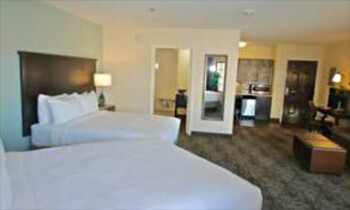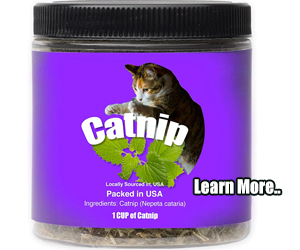The Dingo - Australia's Wild Dog
(Canis lupus dingo)

Dingo on a roadside (Photo:
Jarrod Amoore, Wikimedia Commons)
The dingo arrived in Australia around 2000 BC, probably brought by Asian seafarers in a semi-domesticated state. The timing of its arrival, its solitary habits, and the rigors of the climate isolated it from further domestication. Also called a warrigal, the dingo belongs to a completely different taxonomic group than most dogs, one that was named after it, Canis lupus dingo.
Known to be very shy, dingoes live mainly in the outback of Australia. After sheepherders protested against the loss of their sheep to dingo predation in the 19th century, the "Dingo Fence" was built and completed in 1885. The fence is longer than the Great Wall of China, measuring over 3,400 miles in length, and effectively isolates dingoes from the fertile southeastern part of Australia.
Interesting Facts
- Threatened in the wild, the dingo may "play possum," feigning death to escape an attack.
- The dingo appears in prehistoric images painted or inscribed on rock faces, signifying a spiritual role in Aboriginal life.
- Marking the affinity between the dingo and the Aborigines, puppies sometimes fed at the breasts of Aboriginal women. They were said to comfort women who had lost their babies, or whose children could not survive due to a lack of food. When grown, these dingoes returned to the wild.
- According to another story, the dingo apparently served as a living blanket for the Aboriginals, who used the term "three dog night" to describe a particularly cold night.
- If a dingo loses it mate -- its lifelong partner -- it may mourn itself to death.

Distribution, Habitat and Diet
When the First Fleet, a group of English convicts and their guards, arrived at the future site of Sidney on 26 January 1788, the dingo ranged across most of Australia except for Tasmania. Today, the dingo has been excluded from much of southeastern Australia and the southwestern tip of western Australia.
The adaptable dingo survives in almost all the different habitats that Australia offers as long as there is enough prey, cover and water. It has even increased its population in arid areas where, thanks to European settlements, it has access to more water and to a large introduced rabbit population.
Dingoes eat mostly mammals, though reptiles, birds, invertebrates and seeds are consumed as well. In the northern tropical wetlands, its favored prey include magpie geese, rodents and wallabies; and in the arid central ranges, rabbits, rodents, lizards and red kangaroos. The dingo also scavenges carcasses, and it often caches surplus food.

Dingo in Australia
Gnu License, Wikimedia Commons
Behavior and Life Cycle
The dingo has a flexible social structure, which depends on the nature of its habitat and the availability of prey. Usually the dingo belongs to a pack of sometimes a dozen animals, with a dominant pair and two or three generations of their offspring. A young male may range alone, prospecting for a mate and seeking out new territory.
The dingo adjusts its hunting strategies to the abundance and size of available prey. A large pack may sight, pursue, surround and kill larger animals such as a red kangaroo. The leader of the pack turns the large prey into the path of the pursuing dingoes, which surround and attack the animal. They have also been known to drive animals into fences to corner them. Sometimes the dingoes pursue the prey in relays, driving it to exhaustion before attacking. The pack attacks from several directions, hamstringing an adult quarry, then going for its throat, or the pack may attack a juvenile quarry by attacking the back of the neck. Solitary dingoes, often tracking by scent, may be more successful than a pack when hunting smaller prey such as a rabbit. Dingoes are known to go for the throat when they are able.
The dominant pair of dingoes, who are bonded for life, mate once a year in April or May. A little over two months later, the female delivers a litter of about five blind furry pups, with more males than females. She bears her young in a den located in a natural cave, an abandoned rodent burrow, a hollow log or protruding tree roots. The male and female together rear the young dingoes.

Male dingo with pups
By PartnerHund.com - look at me dad, CC BY 2.0, https://commons.wikimedia.org/w/index.php?curid=6265588
The female nurses her pups for about two months, then weans them. After that, she regurgitates food and water for the pups as they begin leaving the den to learn the art of hunting from both of their parents. They usually stay with the family unit until they are two or three years old. To maintain her dominant role, the female may kill pups borne by other females within her pack.
As they grow and mature, the male will reach sexual maturity at about a year and a half of age, and the female, at about two years of age. In the wild, the dingo typically lives for about five to seven years, although it sometimes lives for ten years.
Perils
In addition to drought, predation, snake bite and hunting injuries -- the dingo suffers from perils introduced by European peoples. It may contract diseases or parasites from domesticated dogs or introduced rabbits. It may fall to the traps, poisons or bullets of livestock owners. Probably most serious of all, the dingo is losing its purity because of spreading hybridization with domesticated dogs. The International Union for Conservation of Nature rates the dingo as "Vulnerable," a threatened species. It is currently under consideration for protection by Australia.
Characteristics of the Dingo
The dingo is a subspecies of the gray wolf (Canis lupus).
- Size and Weight: Measures about 4 feet in length from the tip of the nose to the tip of the tail and almost 2 feet in height at the shoulder; weighs about 35 pounds. The male is larger than the female. The pure dingo varies somewhat in size from region to region.
- Head, Body and Legs: Head fairly broad, muzzle tapered, ears erect, long canine teeth; body lean and muscular; leg length equals about half the head-body length; no dewclaws; hind feet about a third of the leg-length.
- Coat and Color: Body hair short, tail somewhat bushy. Most pure dingoes are ginger-colored, although some may be black and tan and others, black and white. Nearly all have white on their feet and a white tip on the tail.
- Senses: Sharp eyes, acute hearing, keen sense of smell.
- Communication: Issues a range of howls, snuffles and groans to locate and attract pack members and to warn off intruders. Does not bark like a typical domesticated dog. Leaves scent marks by means of urine, fecal matter and scent glands, usually near water sources, hunting grounds and trails to attract mates, rally pack members and proclaim territory.
The Dingo as a Pet
As a breed, the animal, according to some, has proven hard to domesticate, although a dingo that is well-treated and trained from the time it is a small pup could make a good pet--smart, curious, playful. It will require space and a good fence. It cannot be exported for the pet trade, so it may not be readily available.
Read more about the plants and animals of Australia's Great Sandy Desert.
Read more about the geography and climage of the Great Sandy Desert.
Click here for information about more animals .
References:
L. K. Corbett, Australia and Oceania
Richard Kubicki, "Dingo -- Australia's Native Dog"
Dog Breed Information Center.
Share this page on Facebook:
DesertUSA Newsletter -- We send articles on hiking, camping and places to explore, as well as animals, wildflower reports, plant information and much more. Sign up below or read more about the DesertUSA newsletter here. (It's Free.)
The Desert Environment
The North American Deserts
Desert Geological Terms





